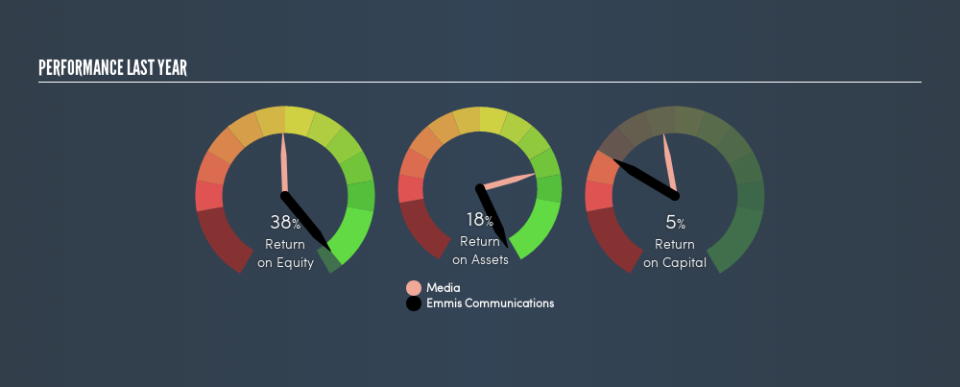Why You Should Care About Emmis Communications Corporation’s (NASDAQ:EMMS) Low Return On Capital

Want to participate in a short research study? Help shape the future of investing tools and receive a $20 prize!
Today we’ll look at Emmis Communications Corporation (NASDAQ:EMMS) and reflect on its potential as an investment. In particular, we’ll consider its Return On Capital Employed (ROCE), as that can give us insight into how profitably the company is able to employ capital in its business.
First of all, we’ll work out how to calculate ROCE. Second, we’ll look at its ROCE compared to similar companies. Finally, we’ll look at how its current liabilities affect its ROCE.
Understanding Return On Capital Employed (ROCE)
ROCE is a measure of a company’s yearly pre-tax profit (its return), relative to the capital employed in the business. Generally speaking a higher ROCE is better. Overall, it is a valuable metric that has its flaws. Author Edwin Whiting says to be careful when comparing the ROCE of different businesses, since ‘No two businesses are exactly alike.’
So, How Do We Calculate ROCE?
Analysts use this formula to calculate return on capital employed:
Return on Capital Employed = Earnings Before Interest and Tax (EBIT) ÷ (Total Assets – Current Liabilities)
Or for Emmis Communications:
0.049 = US$14m ÷ (US$246m – US$60m) (Based on the trailing twelve months to November 2018.)
So, Emmis Communications has an ROCE of 4.9%.
See our latest analysis for Emmis Communications
Does Emmis Communications Have A Good ROCE?
ROCE can be useful when making comparisons, such as between similar companies. In this analysis, Emmis Communications’s ROCE appears meaningfully below the 8.4% average reported by the Media industry. This performance could be negative if sustained, as it suggests the business may underperform its industry. Regardless of how Emmis Communications stacks up against its industry, its ROCE in absolute terms is quite low (especially compared to a bank account). There are potentially more appealing investments elsewhere.
Emmis Communications’s current ROCE of 4.9% is lower than 3 years ago, when the company reported a 11% ROCE. So investors might consider if it has had issues recently.
It is important to remember that ROCE shows past performance, and is not necessarily predictive. Companies in cyclical industries can be difficult to understand using ROCE, as returns typically look high during boom times, and low during busts. ROCE is only a point-in-time measure. If Emmis Communications is cyclical, it could make sense to check out this free graph of past earnings, revenue and cash flow.
How Emmis Communications’s Current Liabilities Impact Its ROCE
Current liabilities include invoices, such as supplier payments, short-term debt, or a tax bill, that need to be paid within 12 months. The ROCE equation subtracts current liabilities from capital employed, so a company with a lot of current liabilities appears to have less capital employed, and a higher ROCE than otherwise. To counteract this, we check if a company has high current liabilities, relative to its total assets.
Emmis Communications has total liabilities of US$60m and total assets of US$246m. As a result, its current liabilities are equal to approximately 24% of its total assets. This is not a high level of current liabilities, which would not boost the ROCE by much.
Our Take On Emmis Communications’s ROCE
Emmis Communications has a poor ROCE, and there may be better investment prospects out there. You might be able to find a better buy than Emmis Communications. If you want a selection of possible winners, check out this free list of interesting companies that trade on a P/E below 20 (but have proven they can grow earnings).
For those who like to find winning investments this free list of growing companies with recent insider purchasing, could be just the ticket.
We aim to bring you long-term focused research analysis driven by fundamental data. Note that our analysis may not factor in the latest price-sensitive company announcements or qualitative material.
If you spot an error that warrants correction, please contact the editor at editorial-team@simplywallst.com. This article by Simply Wall St is general in nature. It does not constitute a recommendation to buy or sell any stock, and does not take account of your objectives, or your financial situation. Simply Wall St has no position in the stocks mentioned. Thank you for reading.

